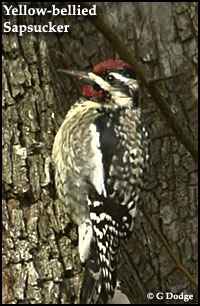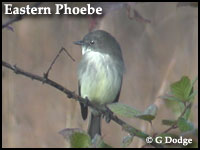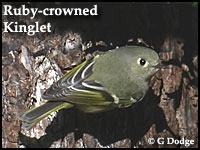 Northern Flickers continue to be observed as they filter through the area. The first-of-the-season Yellow-bellied Sapsucker was seen on October 11 during the Wild About Animals Event. Don’t look for a bright yellow belly on these guys, most of them are rather dingy looking. The white vertical line on the wing (when the bird is perched as in the image at right) is a dead giveaway as to this woodpecker’s identity. They make a catlike meow sound (Gray Catbirds, which also make a somewhat different sounding catlike meow, should be out of the picture soon), and they’re the only woodpecker likely to be heard steadily pecking away on wood at this time of year. Other woodpeckers are still in the area and, indeed, trying to excavate grubs and other insects from the trees but sapsuckers have a continuous Morse Code-like beat. They’re always working. If you hear a tapping in the trees up above, check it out, it’s probably a sapsucker.
Northern Flickers continue to be observed as they filter through the area. The first-of-the-season Yellow-bellied Sapsucker was seen on October 11 during the Wild About Animals Event. Don’t look for a bright yellow belly on these guys, most of them are rather dingy looking. The white vertical line on the wing (when the bird is perched as in the image at right) is a dead giveaway as to this woodpecker’s identity. They make a catlike meow sound (Gray Catbirds, which also make a somewhat different sounding catlike meow, should be out of the picture soon), and they’re the only woodpecker likely to be heard steadily pecking away on wood at this time of year. Other woodpeckers are still in the area and, indeed, trying to excavate grubs and other insects from the trees but sapsuckers have a continuous Morse Code-like beat. They’re always working. If you hear a tapping in the trees up above, check it out, it’s probably a sapsucker.
Sapsuckers make those nice neat elliptical holes in the trunks of trees. The holes are often in a line around the tree. Sometimes there are many, many rows of holes in the trunk and large branches of the tree. The holes fill up with sap. The sap often attracts insects and other birds, including warblers and hummingbirds, so it’s worth keeping an eye on the workings of these industrious seasonal visitors.
 Freshly molted and with a tinge of green on the belly, several Eastern Phoebes have been seen throughout the Explore the Wild/Catch the Wind Loop flycatching insects. Phoebes molt before migration so I don’t know if these birds are migrants or our local nesters. I suspect both. An Eastern Wood Pewee was seen on the first day of this period, 1 October.
Freshly molted and with a tinge of green on the belly, several Eastern Phoebes have been seen throughout the Explore the Wild/Catch the Wind Loop flycatching insects. Phoebes molt before migration so I don’t know if these birds are migrants or our local nesters. I suspect both. An Eastern Wood Pewee was seen on the first day of this period, 1 October.
 Another first-of-the-season bird was a Ruby-crowned Kinglet seen October 4 on a Willow in the Wetlands (image at left). These small, olive-gray bundles of energy will be with us for the rest of the season until about mid March. The one in the Wetlands was perhaps just passing through, but there are more coming. The ruby crown is not often visible. It’s tough to get a shot of one actually showing the red “crown” which lies just beneath the gray-green feathers on the top of the head. This brilliant red tuft of feathers is most often displayed in the spring.
Another first-of-the-season bird was a Ruby-crowned Kinglet seen October 4 on a Willow in the Wetlands (image at left). These small, olive-gray bundles of energy will be with us for the rest of the season until about mid March. The one in the Wetlands was perhaps just passing through, but there are more coming. The ruby crown is not often visible. It’s tough to get a shot of one actually showing the red “crown” which lies just beneath the gray-green feathers on the top of the head. This brilliant red tuft of feathers is most often displayed in the spring.
The warblers seen during the period were Black-throated Green Warbler, American Redstart and Common Yellowthroat, all during the first week of October.